From the Canadian Animal Assistance Team's Board of Directors to all CAAT team members all over Canada:
We want to all express our deepest gratitude to each of you for your participation and dedication to CAAT in 2006. Your suggestions, ideas, sacrificing your time, resources and all the hard work you put in to the spay and neuter projects, your interest and input on the Pet Services Committee (Emergency Preparedness planning for Vancouver), for your involvement, your support, your positive and amazing attitudes, and so much more; for all of this we thank you. We honestly couldn't do what we do for the animals in Canada and around the world if not for dedicated, caring individuals such as yourselves.
We are a team. We appreciate and acknowledge you. May your Christmas be a happy time for you and your families. Thank you ahead of time for your continued participation and dedication in 2007.
The Canadian Animal Assistance Team is made up of veterinary professionals dedicated to the care of animals worldwide. Their mandate is to have an impact on the safety, health and population control of domestic animals worldwide by providing education, providing spay and neuter clinics for domestic animals in rural / underserved areas, ensuring domestic animals are included in disaster response plans, and assisting in relief efforts after natural disasters.
Tuesday, December 19, 2006
Monday, December 18, 2006
Fundraiser Thank-Yous
Our "Pooch Pampering Party" fundraiser, at Heather's Place Doggy Daycare, was a big success! Thank you to all of the participants / volunteers:
1) Dennis & Christine of Big Dog Little Dog Bakery in Burnaby (www.bigdoglittledog.com), for their donation of dog biscuits.
2) A huge thank you to Heather of Heather's Place Doggie Daycare and Grooming in Vancouver, for so generously giving us her facility for the entire day, and for being Santa Claus. We appreciate what you did for us beyond words.
3) Trevor of Pacific Veterinary Sales for donating the shampoo. So much appreciated Trevor!
4) To the amazing CAAT team members who gave up their Sunday to help out - Nadia, Kirsten, Danielle, Carla, Kat, Sean, Norma, Daniel, Aliesha, Davy, Rosie, Kathrin, Angie and Catherine - a huge thank you. Couldn't do this without all of you.
5) Jen and Carmen, our pet photographers, from Hey Mama Creative (www.heymama.ca) - you did a great job. It was fun.
6) To the team members who couldn't be present but provided baked items for the bake sale anyways... Brigitte, Tara, Sarah, Jackie - thanks so much.
7) To Norma - for running all over Vancouver putting up posters, and for taking the table and chairs back to the rental place - thank you hugely.
8) To Jackie - for making bandanas for the dogs; they were wonderful.
9) To Michel - for the wonderful posters you created. Thank you.
10) To Gary - for your help with set-up Saturday evening. You are a lot of fun. Thank you.
11) Last but not least, to Daniel - for his creativity, initiative, organization, extremely hard work, and all the effort and thought he put into this event. You are an amazing man and CAAT is so blessed to have you. Thank you!
1) Dennis & Christine of Big Dog Little Dog Bakery in Burnaby (www.bigdoglittledog.com), for their donation of dog biscuits.
2) A huge thank you to Heather of Heather's Place Doggie Daycare and Grooming in Vancouver, for so generously giving us her facility for the entire day, and for being Santa Claus. We appreciate what you did for us beyond words.
3) Trevor of Pacific Veterinary Sales for donating the shampoo. So much appreciated Trevor!
4) To the amazing CAAT team members who gave up their Sunday to help out - Nadia, Kirsten, Danielle, Carla, Kat, Sean, Norma, Daniel, Aliesha, Davy, Rosie, Kathrin, Angie and Catherine - a huge thank you. Couldn't do this without all of you.
5) Jen and Carmen, our pet photographers, from Hey Mama Creative (www.heymama.ca) - you did a great job. It was fun.
6) To the team members who couldn't be present but provided baked items for the bake sale anyways... Brigitte, Tara, Sarah, Jackie - thanks so much.
7) To Norma - for running all over Vancouver putting up posters, and for taking the table and chairs back to the rental place - thank you hugely.
8) To Jackie - for making bandanas for the dogs; they were wonderful.
9) To Michel - for the wonderful posters you created. Thank you.
10) To Gary - for your help with set-up Saturday evening. You are a lot of fun. Thank you.
11) Last but not least, to Daniel - for his creativity, initiative, organization, extremely hard work, and all the effort and thought he put into this event. You are an amazing man and CAAT is so blessed to have you. Thank you!
Saturday, December 02, 2006
Pooch Pampering Party
On December 10 come to the CAAT fundraiser "Pooch Pampering Party", at Heather's Place Doggy Daycare & Grooming, 141 East 4th Avenue at Main, Vancouver. See the CAAT web site for more details.
Trinidad & Tobago Trip
Earlier this year the Canadian Animal Assistance Team was invited by Theresa Awai of the TTSPCA (Trinidad & Tobago SPCA) to assist them for a two week spay and neuter program greatly needed in their area due to the growing numbers of stray animals roaming the streets. A group of 6 CAAT members, three veterinarians, two technicians and a veterinary assistant left on November 4,2006 to embark on a 14 day journey with the purpose of spaying, neutering, vaccinating, deworming and treating as many animals as we safely could while educating as many people as possible about our mission and the importance of it.
Dr.Ken Seaman (team leader), along with Dr.Rebecca Ferrier, Dr. Ben Weinberger, Jackie Emard, Isabelle L'Hebreux and Katrina Wutke flew to Port of Spain, Trinidad and spent the first couple of days getting settled and sorting supplies at the SPCA where we would be doing the majority of our work. We came with suitcases full of donated medical supplies, medications, and anesthetic drugs, much of which was left behind for the SPCA to make use of when we returned home to Canada.
Once our supplies were organized we were taken by Dr. Raymond Deonanan of the Trinidad SPCA and his assistant Shivani Maharaj to a more remote area of Trinidad called Rio Claro in Mayaro. There, the councilors of Rio Claro opened up a community centre for us that we quickly transformed into a surgical suite.
Despite the initial resistance from the community our four days in Rio Claro ended up very successful. We found the people a little suspicious of us to start off and somewhat confused by what we were there to do but after introducing ourselves, handing out flyers & speaking to some local schools to spread awareness, we watched the community transform and start supporting our mission. The centre we had set up at started buzzing with people coming from all around the area bringing us their animals. We ended up busy enough that our doctors were in surgery over 120 animals for exams, vaccines from 9am to 5pm, hardly taking time for lunches, every day we were there. Not to mention seeing, flea & tick treatments, skin issues, open wounds, broken limbs, infected eyes, and several eye enucleations.
It was a very rewarding week because of the number of animals we were able to treat but also because of the friendships we developed with the local people. People that were originally skeptical ended up spending almost the whole week with us, watching, learning, helping where they could and treating us to an array of the most tasty and beautiful fruits that one could imagine. The pride in their eyes when they would present us with a bag of bananas, portugals, oranges or cocos that were hand-picked from their own backyards was all the thanks we could have asked for. The gratitude came through in such beautiful ways making Mayaro one of the greatest highlights of our trip.
After finishing our work in Mayaro, we took a one day detour to the island of Tobago to see some sights and meet up with the coordinators of the Tobago SPCA. The plans we had made for Tobago took a bit of a backseat to the endless rain and lightning storms that we were told we must have brought with us from Canada! We made the best of our rainy day and still managed to set up some contacts in Tobago should CAAT ever return to the area.
When we made our way back to Port of Spain there were nearly 100 surgeries booked for us. We spent the last leg of our trip doing spays and neuters like a well oiled machine in the tiny little surgery room of the Trinidad SPCA, two dogs to a surgery table, at times. We laughed and sang and enjoyed the company of Dr. Ray, Shivani, Mark and other TTSPCA staff members while working our way through a long list of surgeries.
Nearing the end of our trip we learned of some pretty devastating statistics that we tried to share with the people of Trinidad during the two television interviews and newspaper reports that we gave. Approximately four hundred dogs and cats per month are brought to the TTSPCA and 90% of those animals are euthanized. Many of them are sick or injured and unable to be adopted but even many healthy animals are put to sleep. There simply is not enough space to house such a large number of animals and despite attempts to strengthen the adoption program, fewer people come to the hospital to adopt an animal than those that come to leave an unwanted animal behind.
Still with such an outrageous volume of animals passing through we were all very impressed with the SPCA. It was very well run, very clean and well-staffed with constant help from volunteers for the kenneled animals. Such an effort is put out by all the people involved in the animal’s welfare that it is disheartening to know that they hardly make a dent in the stray population. Hopefully our presence in this country will start the decline in those numbers and that the children from the classrooms we spoke to are of a new and informed generation that supports better care of animals, awareness of the population control issues and that the quality of life for all animals in Trinidad steadily improves.
Dr.Ken Seaman (team leader), along with Dr.Rebecca Ferrier, Dr. Ben Weinberger, Jackie Emard, Isabelle L'Hebreux and Katrina Wutke flew to Port of Spain, Trinidad and spent the first couple of days getting settled and sorting supplies at the SPCA where we would be doing the majority of our work. We came with suitcases full of donated medical supplies, medications, and anesthetic drugs, much of which was left behind for the SPCA to make use of when we returned home to Canada.
Once our supplies were organized we were taken by Dr. Raymond Deonanan of the Trinidad SPCA and his assistant Shivani Maharaj to a more remote area of Trinidad called Rio Claro in Mayaro. There, the councilors of Rio Claro opened up a community centre for us that we quickly transformed into a surgical suite.
Despite the initial resistance from the community our four days in Rio Claro ended up very successful. We found the people a little suspicious of us to start off and somewhat confused by what we were there to do but after introducing ourselves, handing out flyers & speaking to some local schools to spread awareness, we watched the community transform and start supporting our mission. The centre we had set up at started buzzing with people coming from all around the area bringing us their animals. We ended up busy enough that our doctors were in surgery over 120 animals for exams, vaccines from 9am to 5pm, hardly taking time for lunches, every day we were there. Not to mention seeing, flea & tick treatments, skin issues, open wounds, broken limbs, infected eyes, and several eye enucleations.
It was a very rewarding week because of the number of animals we were able to treat but also because of the friendships we developed with the local people. People that were originally skeptical ended up spending almost the whole week with us, watching, learning, helping where they could and treating us to an array of the most tasty and beautiful fruits that one could imagine. The pride in their eyes when they would present us with a bag of bananas, portugals, oranges or cocos that were hand-picked from their own backyards was all the thanks we could have asked for. The gratitude came through in such beautiful ways making Mayaro one of the greatest highlights of our trip.
After finishing our work in Mayaro, we took a one day detour to the island of Tobago to see some sights and meet up with the coordinators of the Tobago SPCA. The plans we had made for Tobago took a bit of a backseat to the endless rain and lightning storms that we were told we must have brought with us from Canada! We made the best of our rainy day and still managed to set up some contacts in Tobago should CAAT ever return to the area.
When we made our way back to Port of Spain there were nearly 100 surgeries booked for us. We spent the last leg of our trip doing spays and neuters like a well oiled machine in the tiny little surgery room of the Trinidad SPCA, two dogs to a surgery table, at times. We laughed and sang and enjoyed the company of Dr. Ray, Shivani, Mark and other TTSPCA staff members while working our way through a long list of surgeries.
Nearing the end of our trip we learned of some pretty devastating statistics that we tried to share with the people of Trinidad during the two television interviews and newspaper reports that we gave. Approximately four hundred dogs and cats per month are brought to the TTSPCA and 90% of those animals are euthanized. Many of them are sick or injured and unable to be adopted but even many healthy animals are put to sleep. There simply is not enough space to house such a large number of animals and despite attempts to strengthen the adoption program, fewer people come to the hospital to adopt an animal than those that come to leave an unwanted animal behind.
Still with such an outrageous volume of animals passing through we were all very impressed with the SPCA. It was very well run, very clean and well-staffed with constant help from volunteers for the kenneled animals. Such an effort is put out by all the people involved in the animal’s welfare that it is disheartening to know that they hardly make a dent in the stray population. Hopefully our presence in this country will start the decline in those numbers and that the children from the classrooms we spoke to are of a new and informed generation that supports better care of animals, awareness of the population control issues and that the quality of life for all animals in Trinidad steadily improves.
Sunday, October 01, 2006
October Happenings
October is a busy and exciting month! The CanWest Veterinary Conference is in Whistler Oct 14th-17th, and CAAT will have it's display booth up and members available to answer questions. The conference will have Veterinarians and Technicians from throughout BC and Alberta, so will be a good member recruitment opportunity.
October 26th-29th is the Abbotsford Dog Show, which is the largest dog show in Canada. It is held at the Tradex Center, where CAAT will again have the display booth set up. In addition, CAAT has been chosen to be one of three charities sponsored and promoted by the Lower Mainland Dog Fanciers. This includes being interviewed for a LMDF show at the Abbotsford Dog Show, to be aired in February on TSN.
Thank you for your continued support.
October 26th-29th is the Abbotsford Dog Show, which is the largest dog show in Canada. It is held at the Tradex Center, where CAAT will again have the display booth set up. In addition, CAAT has been chosen to be one of three charities sponsored and promoted by the Lower Mainland Dog Fanciers. This includes being interviewed for a LMDF show at the Abbotsford Dog Show, to be aired in February on TSN.
Thank you for your continued support.
Wednesday, September 13, 2006
NWT--Lutsel K'e Team

Letter from Lutsel K'e.
What an amazing trip! I'd like first to give a HUGE thank you to our sponsors that made this trip both financially and organizationally possible. There were a few people that put in so much hard work for us and for this we are very grateful.
Our group of four C.A.A.T. members; veterinarian Ken, technician Jennifer, and amazing assistants Corinne and Steve, spent six days in the community of Lutsel K'e. This is a community of the Dene native tribe on the shore of Great Slave Lake. The community contains 300-450 people (depending on who you ask) of which, approximately 1/3 are children. Lutsel K'e has a school (kindergarten to grade 10), a community hall, a new arena, a fire hall, a four bedroom seniors housing complex, a CO-OP store, a church, an RCMP office, the nursing station (where we were housed), and various houses. And of course, many dogs.
 The one hour flight to Lutsel K'e from Yellowknife gave us a great opportunity to see the landscape up close. The rocky terrain has been carved by glacier movement and there are areas where the rock looks like waves. The flora consists mainly of spindly trees and muskeg. There's yellow lichen that grows quite prolifically.
The one hour flight to Lutsel K'e from Yellowknife gave us a great opportunity to see the landscape up close. The rocky terrain has been carved by glacier movement and there are areas where the rock looks like waves. The flora consists mainly of spindly trees and muskeg. There's yellow lichen that grows quite prolifically. The fire hall became our 'clinic'. We set up shop and had our first patient at 3pm - "Myah" whose mom was a Springer spaniel and whose dad was a black Lab. Our clippers did not work at all; this was so frustrating and time consuming having to scissor then cut the hair with a disposable shaving blade.
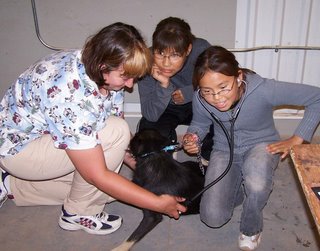 The breeds of the dogs up North aren't what we expected. We had packed for mainly large Husky size dogs. The majority of dogs we saw were less than 40 lbs. What surprised me was the number of 'Wild Shih tzus of the North'. Unfortunately, their hair coats are not conducive to the climate and we saw many Shih tzus who were badly matted and had burrs and grass awns stuck to them.
The breeds of the dogs up North aren't what we expected. We had packed for mainly large Husky size dogs. The majority of dogs we saw were less than 40 lbs. What surprised me was the number of 'Wild Shih tzus of the North'. Unfortunately, their hair coats are not conducive to the climate and we saw many Shih tzus who were badly matted and had burrs and grass awns stuck to them.We were told that dogs at one time served a great purpose in Lutsel K'e. They were used for transportation and survival. Unfortunately, with the majority of people relying now on their ATVs and snowmobiles, the dogs have seemed to become a possession instead of a valued part of the family unit. We saw many dogs that were tied up at all times with no access to fresh water.

A few old traditions still remain. One of these is Dog Island. During the summer months when the ice is off the lake, a small group of community members keep their dogs on a few of the smaller close-by islands. When the lake water freezes enough, the dogs are returned to the village. I believe I'm remembering correctly to say that by doing this keeps the dogs in shape by allowing them to roam free on the island instead of being tied up in town. We were taken on a boat tour by Constable Brent and his fiancé Sherry. We went past one of the dog islands. We could see two male dogs tied up to a cable, an untied bitch and five puppies. I'm not sure why the males were tied up. It seems to contradict the purpose of dog island if the dogs aren't allowed to roam free.
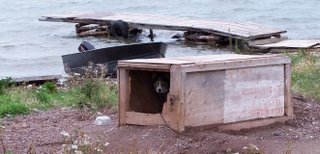
Most of our surgeries were done in the first three days. In total we neutered twenty males, spayed seventeen females and vaccinated/dewormed sixty-four dogs and one cat. Our anesthetics went smoothly for the most part. All the dogs, except the few that Nurse Sheryl had already inoculated, were vaccinated against Distemper, Parvovirus, Rabies, Hepatitis and Parainfluenza as well as dewormed and given an application of Advantage. Every animal we operated on had a bright yellow ear tag placed in their right ear. It was neat to see the ear tags in the dogs around the village after a few days. It made me feel like we were doing something worthwhile. The puppies that had surgery were bouncing around the next day - so much for the strict rest home care recommendations!
Most of the dogs were thin but not too thin. A few of the house dogs (while most were outside dogs there were a few dogs that lived inside the houses) were even chunky! It is much too expensive for most people to be able to ship in kibble dog food. I saw dogs eating mostly leftovers, wild game and fish. The teeth on the younger dogs were mainly tartar free. We didn't see much gingivitis. However, I did see an interesting pinkish discolouration to the enamel on quite a few dogs. Many of the older dogs had tartar, loose teeth, or chipped teeth. Most of the dogs had clean ear canals as well, except where the ever-present flies had bitten the ears along the edges and one old lab that looked to have a chronic ear infection. The skin appeared dry and flakey on a lot of the dogs, where as the fur coats were soft and thick. We didn't see any signs of external parasites other than the fly bitten ears.
We were able to enjoy some fishing in the Snowdrift River which runs along one side of the community. Among the fish caught were a Northern Pike and a 10-11 lb trout that Corinne snagged on her line. We were using a little fish called a Cisco as bait.
The Dene language has a few interesting letters in its alphabet. I don't see any on my keyboard but I'll describe a few. There's a letter that is the top part minus the period of the question mark ( ? ). I didn't find out what sound it made. There are the letters o, d, and g that have horizontal lines through them. Marci cho means thank you. Sa is the word for sun and eenaa is the word for mother.
We popped into the CO-OP store a few times as it was the only place that had a bank machine. I jotted down a few of the prices. $8.00 for a 2 L. carton of milk. $9.89 for 950 mls of Mayonnaise. $3.39 for a can of French style green beans. $9.99 for a 1.36L can of tomato juice. $6.99 for a 1kg bag of frozen green beans. $5.49 for a 950ml bottle of Sunlight dish soap. Needless to say groceries are very expensive on the whole! Nurse Sheryl said she felt diabetes would be a big problem in about ten years as the people are moving away from the traditional lifestyle of eating and exercise. In such a small town, it amazes me how many people ride on their ATVs to go such a short distance. A few people have their groceries flown in from Yellowknife. But at $1 a lb for freight and a 5% packing fee on top of the price of the groceries it still makes food and supplies expensive. Once a year a large barge ships in a lot of the bigger items (i.e. building materials and furniture) and supplies.
Lutsel K'e has an amazing artist by the name of John Rombough. I really liked his artwork and was so appreciative that he stopped by the clinic one day to show us some of his wares. Three of us are now the proud owners of a piece of John's artwork. Nurse Sheryl makes another kind of artwork she calls fish scale art. She dyes then dries fish scales and glues them onto rocks, wood, and bones in the shapes of flowers.
One of the highlights for us carnivores was a meal cooked by Nurse Brenda. We had caribou meat in an onion sauce along with the wild shaggy mane mushrooms we picked on the village outskirts. Caribou meat is so tender and mild tasting. Yum yum! Nurse Brenda said a lot of the people in the community boil their meat and fish. Corinne and I also got to taste fire-cooked fish eggs. There are teepees around the village used to dry meat and fish.

Lutsel K'e has dog shooting days. The people are given a days notice to keep their dogs tied up. On dog shooting day, any dog found at large is shot. There is a $50 bounty on each of the dogs shot. I hope that our yellow tagged dogs will be exempt from being shot. We tried to tell people that the tags meant that these dogs have been spayed/neutered and that other than a reason of a behavior problem these tagged dogs shouldn't be shot. I understand that dog shooting days are a financially economical way to deal with the large dog population problem. However, we heard stories of wonderful friendly dogs getting shot. Another area that needs addressing is the behaviour of the children around the dogs. This would be a great educational service for the community for the next group going to Lutsel K'e to try and initiate.
 I think our entire group had their eyes opened to another part of huge and wonderful country. I can only express my own excitement of the trip but I think it would be shared by all in our group. Lutsel K'e is an amazing land and the Dene people are an amazing people. I hope we were able to plant a few seeds that will grow into a solution for the dog problem in Lutsel K'e.
I think our entire group had their eyes opened to another part of huge and wonderful country. I can only express my own excitement of the trip but I think it would be shared by all in our group. Lutsel K'e is an amazing land and the Dene people are an amazing people. I hope we were able to plant a few seeds that will grow into a solution for the dog problem in Lutsel K'e. Lastly a special thank you to the owners of the following dogs. You trusted a group of white strangers with your dogs and I hope you know how thankful we are to be given the responsibility to help you with your dog problem. Without your participation, our project wouldn't have been the success it was. Myah, Zeus, Browny, Scruffy, Duke, Memphis, Weasel, Airhaw, Angel, Sleepy, Winter, Tolson, Socks, Trigger, Cheeta, Spike, Nuts, Tess, Dakota, Candy, Garfield (the cat), Melody, Dodger, Chub Chubs, Princess, Penny, Sacho, Sasha, Rex, Butch, Scooter, Killer, Lucky, Otis, Shadow, Delgah, Puppy, Boxer, Champ, Whitey, Beethoven, Raven, Spark, Melo, Gizmo, and the many unnamed puppies.
- Jennifer Rabie, Registered Animal Health Technologist, Summerland, BC
Thursday, September 07, 2006
NWT--Days 7 & 8

DAY SEVEN: September 3, 2006
Today was our rest and relaxation day. After breakfast, we drove to a First Nations village, Dettah, just east (I think) of Yellowknife. Doug gave us a tour, including the cemetery and showed us where the ice road is in the winter, on the lake. Fascinating cultures in the communities we have lived in, worked in, and visited over the past week.

We then continued on to Cameron Falls, where we hiked over very rocky terrain for about thirty minutes to see the magnificent waterfall. We stopped and spoke with a couple visiting from Brampton, Ontario. They have come a long way also.
At 3:00 pm the four remaining team members flew in to Yellowknife from Lutsel K’e, and our reunited team spent the rest of the day and evening sharing stories and experiences. The Lutsel K’e team – Ken, Steve, Corinne and Jennifer - had been fishing over the last couple of days and brought back several large trout they had caught. Doug and Candy barbequed the fish for our dinner tonight and were able to put some away in their freezer for another time also. A prominent native artist also lives in Lutsel K’e, so that team was able to purchase some of his artwork. Ken brought back a four foot high rack of caribou antlers he had “found” in the community. It will be fun getting that back to Vancouver Island tomorrow.

Jennifer has been keeping a daily journal of her team’s time in Lutsel K’e and has graciously offered to do a write up of their week working and living in that community. We will post it to the blog ASAP.

Our flight leaves for home tomorrow morning at 7 am. It is now close to midnight and we all need to be up and leaving for the airport by 6 am. It will be a short sleep.
 We have been able to see the Northern Lights several evenings this week – very impressive to say the least.
We have been able to see the Northern Lights several evenings this week – very impressive to say the least. DAY EIGHT: September 4, 2006
 Our day began at 4:45 am with the smell of fresh coffee brewing and the sound of Doug moving about in the kitchen. The sunrise was gorgeous as we drove to the airport. We had no trouble checking in all of our luggage and medical supplies at the First Air ticket counter. Several of our team were searched at security though and even had “Chapstick” confiscated.
Our day began at 4:45 am with the smell of fresh coffee brewing and the sound of Doug moving about in the kitchen. The sunrise was gorgeous as we drove to the airport. We had no trouble checking in all of our luggage and medical supplies at the First Air ticket counter. Several of our team were searched at security though and even had “Chapstick” confiscated. 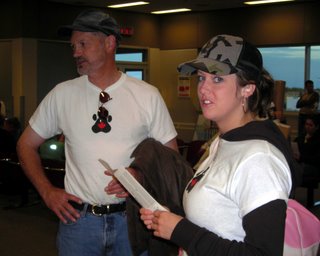
The flight from Yellowknife to Edmonton was smooth and uneventful. Jennifer asked the flight attendant if she could speak on the microphone. She gave First Air a huge thank you for the donation of flights to our team and making it possible for the eleven of us to do the work we did in the North. The entire team clapped and cheered at the end. Upon arrival at the Edmonton airport we had a team photo taken in front of First Air’s sign.
 Liz, Jennifer and Donna settled into the comfy leather chairs in the departure area to guard everyone’s luggage as the rest of the team took the shuttle to West Edmonton Mall. We had a seven hour layover in Edmonton. We read, did crossword puzzles, Soduku puzzles, played cards, ate, talked and slept. The rest of the team returned to the airport by 2:30 at which time we checked in at the Westjet counter, boarded our plane for home and flew out of Edmonton at 5:00 pm, arriving in Vancouver at 5:05pm. Five minute flight. One hour time difference.
Liz, Jennifer and Donna settled into the comfy leather chairs in the departure area to guard everyone’s luggage as the rest of the team took the shuttle to West Edmonton Mall. We had a seven hour layover in Edmonton. We read, did crossword puzzles, Soduku puzzles, played cards, ate, talked and slept. The rest of the team returned to the airport by 2:30 at which time we checked in at the Westjet counter, boarded our plane for home and flew out of Edmonton at 5:00 pm, arriving in Vancouver at 5:05pm. Five minute flight. One hour time difference. 
Goodbyes were exchanged in Vancouver, with all team members expressing their thankfulness and appreciation for the wonderful experience and adventure in the Canadian north. It has been a very rewarding and wonderful week. We are confident that what we accomplished in the Northwest Territories will make a noticeable difference in the communities in which we worked. We are confident the dog-bite incidence will decrease, as well as the numbers of stray dogs and owned dogs will be decreased. The health of the community will also be improved as there will be a decrease in the transference of parasites and possibly rabies from the dogs to the humans. We are very grateful for the opportunity to assist our country in whatever way we can, and are very proud of the great work we accomplished in the Northwest Territories. We have been invited to return next year to work in other communities in the north.
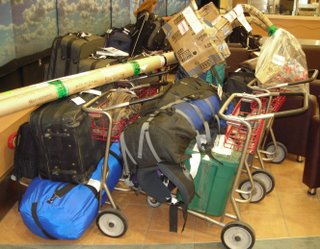
Tuesday, September 05, 2006
NWT--Day 6

DAY SIX: Sept.2, 2006
Lorraine flew home to Kelowna this morning. Before Doug took her to the airport he dropped the rest of the team in downtown Yellowknife for a couple of hours to explore and shop for souvenirs.
We left town after lunch to drive out to Rae-Edzo. Along the way, we stopped and climbed up on the rocks to have our photo taken by Doug, next to an inukshuk which was there already.
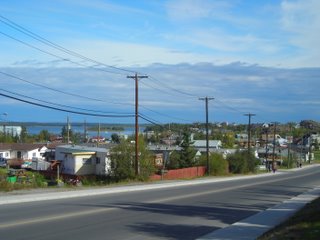
Arriving in Rae at the garage, we found the doors locked so we spent the next hour or so tracking down the keys, and also having the opportunity to drive through the community once again and take photos. We were approached by a very famous local artist by the name of Archie Beaulieu, who wanted us to vaccinate and deworm his thirty-three sled dogs. He brought us some of his very valuable prints to show us, and several of us ended up purchasing a print to take home. He is an amazing artist and we felt very privileged to be able to meet him and purchase a signed painting. He cut us a good deal on the paintings in exchange for helping him with his dogs.
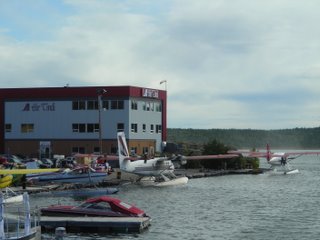
Unable to find any more dogs to operate on, we packed up our equipment and drove home to Yellowknife, and to bed before midnight for the first time all week.
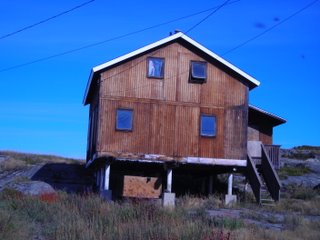
Monday, September 04, 2006
NWT--Day 5
DAY FIVE: Sept 1, 2006
A couple of important points from yesterday I had forgotten to write about. Firstly, a news crew from APTN (Aboriginal Public Television Network) showed up at the garage where we were working to film and interview us for a news report. More publicity for CAAT and for the difference our teams are making here in the north. We’ve been told that CBC North television is also coming today for a news piece on us also.
Also yesterday afternoon, several First Nations girls stopped by the garage, curious about what we were doing. They were very interested in watching the surgeries, bombarding us all with many questions, helped with holding animals and later delivering animals to their homes. Perhaps this is a start towards changes in attitudes here toward the treatment of their dogs. We realized that we need to begin setting aside time on each spay and neuter project to perhaps visit the elementary schools and begin to educate the children on how to approach/or not to approach dogs, proper feeding and handling of their dogs, etc, and hopefully the incidence of dog bites and therefore the shooting of dogs will be eliminated.
Today, unfortunately, was a day of emotional lows. We arrived in Rae by 1 pm and had a bit of lunch. CBC North told us they were going to come to interview us today, so we were hopeful we would have some dogs to operate on. However, we were having trouble finding and rounding up dogs that we hadn't already spayed/neutered. We have put a brightly coloured plastic tag (“No shoot tags” they came to be called) in each dog’s ear while they were under anesthetic, to show clearly that they had been operated on, dewormed and vaccinated. We have been surprised that the numbers were certainly quite less than we were told when we were planning this project. We were told later, by one of the townspeople, the reason for this. The day before we arrived to work in the community at the beginning of the week, the community’s chief administrating officer gave the order to go out and collect and shoot every dog which was running loose in the community. “Clean up the town” they were told. This explained the shortage of dogs in the community. This news was very hard to take. The people had taken care of the situation in their own way. Somehow communication and trust were not as good as we thought.
The first dog which was brought in gave us some anesthetic difficulties and challenges and we nearly lost her. She was very much in heat and was exhibiting some cardiac irregularities once she was given her injectable anesthetic. We decided not to go ahead with the spay and let her wake up instead. It is difficult to do field surgeries as we are doing because we are unable to do bloodwork to check organ function on the dogs before anesthetizing them, so risk of anesthetic complications or even death is increased.
We had a small Papillon-type dog whose heart stopped beating during her spay and we were unable to bring her around, despite desperate attempts to revive her. It certainly put a darker cloud over the rest of our day. Again, if we could have done bloodwork on her before anesthetizing her, we perhaps would have refused to operate on her or would have been able to change our anesthetic protocol somewhat.
We must remain encouraged that we have influenced the attitudes of many of the children who watched and helped us. When we first arrived on Tuesday, one of the public works’ foremen, Gary, had a very rough and tough exterior, complaining to us about the dogs in the community and how much he hates dogs. By the end of the week and his observing our ways with the dogs, we had talked him into taking a dog home with him. He would walk in to the building we were working in and would bend down and start petting and talking to the dogs. It was pretty amazing to see the attitudes change throughout the week.
CBC North appeared mid-afternoon and interviewed us while we worked. It will appear on CBC Arctic satellite channel this Tuesday evening, Sept 5 on the 6pm evening news.
We were hoping to see buffalo while in the north. Thus far on our hour long drives we have observed three fox, two wolves and many many ravens. We arrived home tonight at about 10:30 pm, had a bite to eat and went to bed.
A couple of important points from yesterday I had forgotten to write about. Firstly, a news crew from APTN (Aboriginal Public Television Network) showed up at the garage where we were working to film and interview us for a news report. More publicity for CAAT and for the difference our teams are making here in the north. We’ve been told that CBC North television is also coming today for a news piece on us also.
Also yesterday afternoon, several First Nations girls stopped by the garage, curious about what we were doing. They were very interested in watching the surgeries, bombarding us all with many questions, helped with holding animals and later delivering animals to their homes. Perhaps this is a start towards changes in attitudes here toward the treatment of their dogs. We realized that we need to begin setting aside time on each spay and neuter project to perhaps visit the elementary schools and begin to educate the children on how to approach/or not to approach dogs, proper feeding and handling of their dogs, etc, and hopefully the incidence of dog bites and therefore the shooting of dogs will be eliminated.
Today, unfortunately, was a day of emotional lows. We arrived in Rae by 1 pm and had a bit of lunch. CBC North told us they were going to come to interview us today, so we were hopeful we would have some dogs to operate on. However, we were having trouble finding and rounding up dogs that we hadn't already spayed/neutered. We have put a brightly coloured plastic tag (“No shoot tags” they came to be called) in each dog’s ear while they were under anesthetic, to show clearly that they had been operated on, dewormed and vaccinated. We have been surprised that the numbers were certainly quite less than we were told when we were planning this project. We were told later, by one of the townspeople, the reason for this. The day before we arrived to work in the community at the beginning of the week, the community’s chief administrating officer gave the order to go out and collect and shoot every dog which was running loose in the community. “Clean up the town” they were told. This explained the shortage of dogs in the community. This news was very hard to take. The people had taken care of the situation in their own way. Somehow communication and trust were not as good as we thought.
The first dog which was brought in gave us some anesthetic difficulties and challenges and we nearly lost her. She was very much in heat and was exhibiting some cardiac irregularities once she was given her injectable anesthetic. We decided not to go ahead with the spay and let her wake up instead. It is difficult to do field surgeries as we are doing because we are unable to do bloodwork to check organ function on the dogs before anesthetizing them, so risk of anesthetic complications or even death is increased.
We had a small Papillon-type dog whose heart stopped beating during her spay and we were unable to bring her around, despite desperate attempts to revive her. It certainly put a darker cloud over the rest of our day. Again, if we could have done bloodwork on her before anesthetizing her, we perhaps would have refused to operate on her or would have been able to change our anesthetic protocol somewhat.
We must remain encouraged that we have influenced the attitudes of many of the children who watched and helped us. When we first arrived on Tuesday, one of the public works’ foremen, Gary, had a very rough and tough exterior, complaining to us about the dogs in the community and how much he hates dogs. By the end of the week and his observing our ways with the dogs, we had talked him into taking a dog home with him. He would walk in to the building we were working in and would bend down and start petting and talking to the dogs. It was pretty amazing to see the attitudes change throughout the week.
CBC North appeared mid-afternoon and interviewed us while we worked. It will appear on CBC Arctic satellite channel this Tuesday evening, Sept 5 on the 6pm evening news.
We were hoping to see buffalo while in the north. Thus far on our hour long drives we have observed three fox, two wolves and many many ravens. We arrived home tonight at about 10:30 pm, had a bite to eat and went to bed.
Sunday, September 03, 2006
NWT--Day 4

DAY FOUR: AUG. 31, 2006
After a good night’s sleep, we started out the day by stopping in at Doug’s government office and meeting all of his co-workers, while Doug picked up more Rabies vaccine. The NWT government has provided all Rabies vaccines. We traveled on to Rae-Edzo, arriving at 11 am. Doug immediately went out searching for dogs he could catch and bring in for us as the team set up and prepared for the day’s surgeries. There was a funeral today in the community so we quickly realized the day might go slowly as most of the community would be attending the funeral and unable to bring in their dogs.

 The dogs which were brought in to us today seemed mostly to be females, and turned out to be complicated surgeries – mature spays, in-heat spays – which were time consuming. All went well though, and we plugged away until 10:30 pm, a total of 21 dogs operated on today.
The dogs which were brought in to us today seemed mostly to be females, and turned out to be complicated surgeries – mature spays, in-heat spays – which were time consuming. All went well though, and we plugged away until 10:30 pm, a total of 21 dogs operated on today. 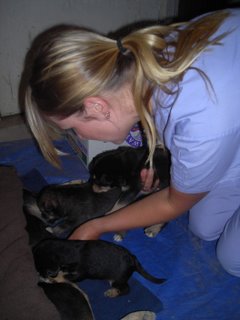 Doug received a phone call from the team in Lutsel K’e, requesting that they be allowed to stay there until Sunday and work. They report that people are lined up at the door with their animals, unlike in Rae where Doug has to go out and look for them and catch them. Lorraine, the freelance journalist, flew back from Lutsel K’e today and joined us, reporting on the team there and all they are doing. A report will be posted on the website at a later date by Lorraine about Lutsel K’e. Doug will arrange the flight changes for the four other team members to remain on in that community.
Doug received a phone call from the team in Lutsel K’e, requesting that they be allowed to stay there until Sunday and work. They report that people are lined up at the door with their animals, unlike in Rae where Doug has to go out and look for them and catch them. Lorraine, the freelance journalist, flew back from Lutsel K’e today and joined us, reporting on the team there and all they are doing. A report will be posted on the website at a later date by Lorraine about Lutsel K’e. Doug will arrange the flight changes for the four other team members to remain on in that community.
Arriving home at 11:45 pm, we had a quick bite to eat and crawled into our sleeping bags.
Saturday, September 02, 2006
NWT--Day 3

DAY THREE: August 30, 2006
With a 6:30 am wake-up time, we were ready to head out by 8:00 am, eager to get back to work in Rae-Edzo. Shortly after our arrival at the community Public Works building, Doug went out, catch pole in hand, to round up some dogs to bring in for us. Apparently the community doesn’t come alive until around 11 A.M. every morning, so we were keeping our fingers crossed that Doug would have some success with dog-catching. We didn’t need to doubt his determination or abilities because in a very short time he was back, dog or two in tow.
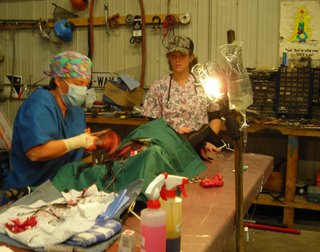
We worked non-stop throughout the day until 7:30 pm, stopping only in shifts for a lunch break, and even though there were several complicated and time-consuming surgeries (pregnant and in-heat spays), we managed to complete 18 spays and neuters today. We had contact this morning from our five team members in Lutsel K’e and were assured they were doing very well, were working hard and getting much accomplished also. They will be joining us this Friday, and we will travel together to Rae-Edzo on Saturday and perhaps Sunday to continue spaying/neutering in this community.
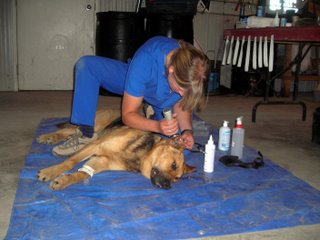 The NWT government (Health Authority) has provided us with enough Rabies vaccines for all of the animals we see this week. Wyeth Animal Health generously provided us with Distemper/Parvo combination vaccines and also some cat vaccines if we need them for this project. Bayer Animal Health provided us with deworming and flea medication for which we are so very grateful. Other than being slightly dirty, the dogs here are in amazingly good shape. We are seeing many German Shepherds and Shepherd cross dogs, lab crosses, a few Huskies, and some puppies yesterday which looked similar to Corgi crosses. Even a small poodle was brought in by its owner yesterday for vaccinations.
The NWT government (Health Authority) has provided us with enough Rabies vaccines for all of the animals we see this week. Wyeth Animal Health generously provided us with Distemper/Parvo combination vaccines and also some cat vaccines if we need them for this project. Bayer Animal Health provided us with deworming and flea medication for which we are so very grateful. Other than being slightly dirty, the dogs here are in amazingly good shape. We are seeing many German Shepherds and Shepherd cross dogs, lab crosses, a few Huskies, and some puppies yesterday which looked similar to Corgi crosses. Even a small poodle was brought in by its owner yesterday for vaccinations.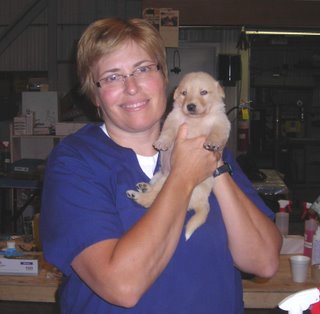 The surgeries are going very well – no problems whatsoever with the anesthetics or the recoveries of the dogs. Thus far, the project is very successful. There just aren’t enough hours in a day to get to all of the dogs in this community. We are making a difference here though, for both the dogs and for the safety and health of the people. It is very rewarding. We wish we could stay for two weeks and help more, but the funding only allowed for one week.
The surgeries are going very well – no problems whatsoever with the anesthetics or the recoveries of the dogs. Thus far, the project is very successful. There just aren’t enough hours in a day to get to all of the dogs in this community. We are making a difference here though, for both the dogs and for the safety and health of the people. It is very rewarding. We wish we could stay for two weeks and help more, but the funding only allowed for one week.Arriving back at 9 pm to Doug’s home, we had our dinner and headed for our sleeping bags and a well-deserved sleep.

Friday, September 01, 2006
NWT--Day 2

DAY TWO: Aug. 29,2006
Our day began at 6:30 am with a wonderful breakfast prepared by Doug, showers, organizing of medical supplies for the day, and with saying ‘see you soon’ to five of our team members – Ken, Corinne, Jennifer and Steve and Lorraine. This team boarded an Air Tindi flight to Lutsel K’e, a community of approximately 450 people on the eastern end of the Great Slave Lake. They will be spaying, neutering, deworming and vaccinating the dogs in this remote community for four days, and will then return and join the other six team members for the last two days of our stay in the north. And hopefully get some fishing in also.

The remaining six team members headed north 110 km to begin our first day of work in Rae-Edzo. We had our first glimpses of the NWT terrain – many rocks, short trees and numerous small lakes.
 After a short tour of the town of approximately 1300 people and a quick lunch, we set up our clinic in the Public Works building, concrete floors surrounded by wall to wall tools and equipment. The workers were wonderful, bringing us anything we needed and asked for, such as tables, lights, paper towels, etc. Doug helped to round up dogs, both stray and owned, and brought them in to us one by one. We worked steadily for four hours and spayed/neutered/vaccinated/ dewormed/cleaned ears/trimmed nails on eleven dogs. All of the dogs received a long-acting antibiotic injection before surgery end and recovered smoothly and without complications. One of the dogs that we spayed had an upper molar which was so covered in tartar and so decayed that part of the gum was very inflamed and worn away. The tooth was slightly loose, but having no dental instruments with us, we looked around the garage we were working in for a pair of pliers to pull the tooth. The pliers kept on slipping off the tooth and so Doug picked up a pair of vice-grips and handed them to us. They did the trick! The tooth came out with all three roots amazingly intact. It is truly amazing what one can do if one gets creative and resourceful. We sutured up the empty socket and woke up the dog.
After a short tour of the town of approximately 1300 people and a quick lunch, we set up our clinic in the Public Works building, concrete floors surrounded by wall to wall tools and equipment. The workers were wonderful, bringing us anything we needed and asked for, such as tables, lights, paper towels, etc. Doug helped to round up dogs, both stray and owned, and brought them in to us one by one. We worked steadily for four hours and spayed/neutered/vaccinated/ dewormed/cleaned ears/trimmed nails on eleven dogs. All of the dogs received a long-acting antibiotic injection before surgery end and recovered smoothly and without complications. One of the dogs that we spayed had an upper molar which was so covered in tartar and so decayed that part of the gum was very inflamed and worn away. The tooth was slightly loose, but having no dental instruments with us, we looked around the garage we were working in for a pair of pliers to pull the tooth. The pliers kept on slipping off the tooth and so Doug picked up a pair of vice-grips and handed them to us. They did the trick! The tooth came out with all three roots amazingly intact. It is truly amazing what one can do if one gets creative and resourceful. We sutured up the empty socket and woke up the dog. 
The highlight of the day was observing Barb suddenly come flying through the outside door, holding on to the collar of a large, black dog, and literally knocking the dog to the floor and smoothly landing on top of him, pinning him to the ground. He had been sedated outside and was just not willing to let his body give in to the sedation. We all cheered her rodeo-like approach to dog-wrangling. Quite impressive she was.
 As we drove back to Yellowknife at the end of the day, over the extremely bumpy pavement, we observed one important fact - the yellow line down the middle of the highway isn’t there to divide the road; the drivers drive down the middle of the road and sometimes completely into the other lane. Only when they see a vehicle approaching from the opposite direction do they move over into their proper lane. It can be a little unnerving to experience this.
As we drove back to Yellowknife at the end of the day, over the extremely bumpy pavement, we observed one important fact - the yellow line down the middle of the highway isn’t there to divide the road; the drivers drive down the middle of the road and sometimes completely into the other lane. Only when they see a vehicle approaching from the opposite direction do they move over into their proper lane. It can be a little unnerving to experience this.
We have not been able to observe the Northern Lights as yet, due to the overcast conditions since we arrived on Monday evening. We have been told that on a clear night, they are quite beautiful and alive this time of year. We are all hoping to experience this before our time here is complete.
--Donna Lasser, Team Leader
Wednesday, August 30, 2006
Northwest Territories Project
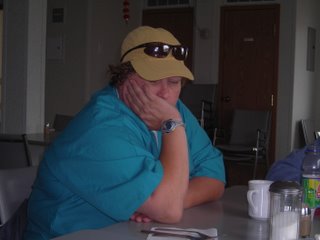
DAY ONE: August 28,2006
Team Northwest Territories met at the Vancouver airport to begin our northern adventure. The team consisted of Dr. Liz Bartlett (Langley BC), Dr. Brigitte Rudolf (Burnaby, BC), Dr. Ken Seaman (Courtney,BC), Robyn Luscombe (technician –Squamish BC), Kristina Gansen (tech – Comox BC), Jennifer Rabie (tech – Summerland BC), Donna Lasser (tech – Hope BC), Steve Howe (Sequim, Wa,) Corinne Barker and Barb Ashmead (Assistants – Vancouver Island). Before we checked ourselves in at Westjet for our flight to Edmonton and then on to Yellowknife, and so not to exceed our available baggage and weight allowance, we had to distribute all of our medical supplies amongst ourselves, in every nook and cranny and available space in our suitcases and backpacks. Somehow we managed to squeeze it all in somewhere, and made it through check-in with no problems or extra costs whatsoever.
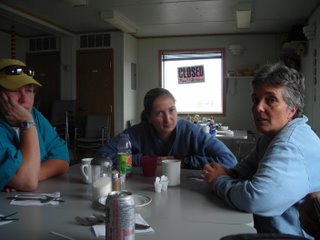
We were carrying an insulated bag filled with vaccines on ice packs which Wyeth had so generously donated for this project, and somehow Kristina managed to end up carrying the bag as one of her carry-on pieces of luggage. As she went through security she was asked what was in the bag and was pulled aside immediately and questioned at length. The rest of the team noticed Kristina hadn’t yet come through security and met up with us, so Ken volunteered to go looking for her. He finally found her and he was able to produce a copy of his Veterinary license. This helped the case for the vaccines to be let on to the plane, but it wasn’t enough. I wondered what was taking Ken and Kristina so long so I went to investigate. When I realized the hassle these vaccines were causing, I offered the security officer a letter from the NWT government stating why CAAT had been invited to come north and what we were going to be doing there, including vaccinating hundreds of dogs. We were then told we were okay to proceed.

The flight from Vancouver to Edmonton was one hour in length, and we had a three hour wait for the connecting flight with First Air to Yellowknife NWT. Lorraine, a journalist from Kelowna, met up with us in Edmonton to continue on with us. We spent a large part of that time as a group, going over the details of what the project was all about, what to expect to see and do, the anesthetic protocols, etc. Just as we were about to go to our boarding gate, we were told the plane was delayed for two more hours. First Air graciously apologized and gave us each a $17 free dinner voucher to use in one of the airport’s restaurants.
By the time our flight arrived in Yellowknife, it was 10:30pm Mountain time, and we were quite exhausted. We were met by the government agent from Yellowknife who made it all possible for us to come to the NWT and offer our services. He had rented a 10 passenger van and managed to squeeze all of us and all of our luggage and medical supplies into the vehicle for the ten minute drive to his home. We used up every bed and any available floor space in his house, sleeping bags everywhere, and settled in for a short but restful sleep, eager and ready to begin our adventure next day.
---Donna Lasser, Team Leader
Saturday, August 05, 2006
Summer Happenings
The Pet Services Committee has had one meeting and another is pending. Twelve of the 15 members were present for the first meeting, which consisted of a brainstorming session and training information. It is a daunting task, but with the commitment of the committee members, it will be worth it for the animals of Vancouver.
The Northwest Territories SNP is officially scheduled for August 28th to September 10th. Thanks to much work by CAAT member Dr. Gord Krebs, a team of Veterinarians and Technologists will travel to four villages over two weeks. They hope to vaccinate and sterilize 250 to 300 dogs.
Initial plans are in the works for a SNP in Trinidad in November. A woman there who runs a shelter has contacted us asking for help. She has one veterinarian who works at the shelter, but cannot keep up with all the strays that run the streets. We hope to send a team of 2-3 veterinarians and 6-8 technologists.
If you would like further information, please go to www.caat-canada.org, or call 1-888-500-3330.
The Northwest Territories SNP is officially scheduled for August 28th to September 10th. Thanks to much work by CAAT member Dr. Gord Krebs, a team of Veterinarians and Technologists will travel to four villages over two weeks. They hope to vaccinate and sterilize 250 to 300 dogs.
Initial plans are in the works for a SNP in Trinidad in November. A woman there who runs a shelter has contacted us asking for help. She has one veterinarian who works at the shelter, but cannot keep up with all the strays that run the streets. We hope to send a team of 2-3 veterinarians and 6-8 technologists.
If you would like further information, please go to www.caat-canada.org, or call 1-888-500-3330.
Friday, May 26, 2006
CAAT Named Pet Services Coordinator
CAAT put forth a proposal at the Emergency Social Services Pet Services Committee meeting last night in Vancouver to become the Pet Services Coordinator for the City of Vancouver. The committee, consisting of representatives from the Vancouver Pound, Vancouver Parks and Rec, the SPCA, etc, voted unanimously in favor. As the Pet Services Coordinator, CAAT will form a Pet Services committee. This committee will begin to draw up plans for the evacuation, sheltering, treatment and ongoing care of animals, and organizing volunteers to run the shelter/reception centre, in the event of a disaster in Vancouver. CAAT will work in conjunction with other groups such as the SPCA and humane society, both before and during a disaster, but will be the 'go-to' organization in the event of a disaster in Vancouver. CAAT hopes to set the standard protocols/template for other cities in Canada to follow.
For more information, you can email us at info@caat-canada.org, or call 1-888-500-3330.
Note: Pictures have been added to final Fiji posting.
For more information, you can email us at info@caat-canada.org, or call 1-888-500-3330.
Note: Pictures have been added to final Fiji posting.
Sunday, May 21, 2006
The Final Four Days
April 13, 2006
Last day of work! We were supposed to split into two groups, but one of the villages was in the opposite direction of the others. As we only had access to one boat today, we all headed back to near the airstrip. My group went to Namara, and the other two groups went to Namalota, just up the road.

Our group set up with a very shaky surgery table. It leaned. A lot. We had Joseph tell the villagers we were there, and asked him to round up some dogs. He came back a few minutes later with a two month old pup, a female. We sedated her, and Joseph was back a few minutes later with her two littermates, both females. Then an adult female and another female pup. Five spays in a row; haven't had to deal with that yet. A lot more stressful and time consuming! We got through them fine, and then had five neuters in a row, so it all evened out.
 The villagers were again very welcoming. The house we set up in front of made us hot chocolate and crackers. We left them our tarp as well as fishing line and hooks, as well as many toothbrushes and gifts. We again took pictures of the children and they all loved to see themselves. I even had a father ask to have his picture taken with his child.
The villagers were again very welcoming. The house we set up in front of made us hot chocolate and crackers. We left them our tarp as well as fishing line and hooks, as well as many toothbrushes and gifts. We again took pictures of the children and they all loved to see themselves. I even had a father ask to have his picture taken with his child.  It's nice to be able to do something so ordinary (to us) and have it give so much pleasure. Same for the surgeries I guess--it is so natural for us and we are so honoured to be able to come into their villages and use our talents--but they are tremendously grateful to us.
It's nice to be able to do something so ordinary (to us) and have it give so much pleasure. Same for the surgeries I guess--it is so natural for us and we are so honoured to be able to come into their villages and use our talents--but they are tremendously grateful to us.

There were many more dogs in this village than the ten we were able to do. We asked owners of other dogs, but they didn't want their dogs to have the surgery. Unsure why, but we can't force them.
We met up with the other groups in the big village, and they had already done 30! While we were walking to them, there was a bit of a downpour--it only lasted a few minutes, but we were soaked. It was actually quite refreshing.
They had two dogs sedated when we arrived, so we took a neuter, while they did the other. We then did a cat neuter, and one other dog spay. Jus as we were getting going on the spay, the skies opened up. It was an amazing rainfall. It lasted for about ten minutes, and there were huge puddles when it was over. We had to move the surgery tables from under the trees to under cover as were were getting drenched.
We finished the surgeries and we packed up while they were recovering. As were were walking out of the village, we ran into the health officer for the area, so Terrill showed and explained the ear tags. He recommended we write up a report to the Agriculture officer (the one responsible for the poisonings) to be sure it was all documented so these dogs would be spared.
Up to this point, our total is 196 surgeries. We are very proud of what we have done here. There are 6-7 dogs in Zachariah's village that may be brought to the resort for us to do tomorrow, but even if we don't, we have done amazingly well. Now for a couple days rest before we head for home.
April 14, 2006
Well, in spite of no alarm, I was awake at 6:15. I lay in bed for awhile, then wandered down to the beach with a cup of coffee.
After breakfast, some of the group went diving. I sat on the beach and read my book and relaxed. There were four dogs and a cat brought form the nearby village, so I got set up for their surgeries and when everyone came back from diving, we did them. That brought our total to 201. We had some lunch and then the divers got ready for another dive. Gord and I got ready for some fishing!
 Zachariah took us out on the boat. He really wanted to find us some tuna. I just wanted to fish! I caught the first one, a big Spanish Mackerel. It was awesome--I don't think I've ever even seen a fish that big up close. The guys were mad, cause I used my "Heeeeeeere, fishy, fishy, fishy" lure and it worked! I caught then next one too. It was a bit smaller. Gord caught a big barracuda. It was a really great time. We saw an amazing sunset.
Zachariah took us out on the boat. He really wanted to find us some tuna. I just wanted to fish! I caught the first one, a big Spanish Mackerel. It was awesome--I don't think I've ever even seen a fish that big up close. The guys were mad, cause I used my "Heeeeeeere, fishy, fishy, fishy" lure and it worked! I caught then next one too. It was a bit smaller. Gord caught a big barracuda. It was a really great time. We saw an amazing sunset.

We showed off our catch and gave it to the kitchen. They said they would cook it for dinner tomorrow.
The rest of the evening was spent with a drink or two on the beach, and some great conversation. I was in bed early again. Just wiped from our two weeks here.

April 15th, 2006
Our last day...Up early again for coffee on the beach. After breakfast, most of us went either diving or snorkeling. I finally got brave and free dove down about 10 feet. It was so great. I got very close to the most beautiful fish. I've only ever been that close when they were in an aquarium.
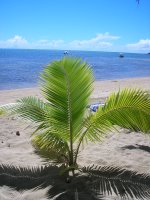
It is a beautiful day for our last one here. Few fluffy white clouds, but otherwise blue sky and sunshine. I am sitting on the beach as I write this with a puppy around somewhere, and Scarface, the local dog, chasing a bird down the beach. Happiness is...
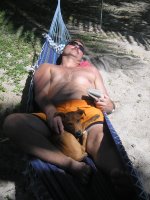 See the puppy?
See the puppy?
We went snorkeling again later, Donna, Norma and I. We kayaked out to a nearby reef. We took some great underwater photos. It was quite breezy and there was a bit of an undertow to contend with. Paddling back to shore took some muscles too!
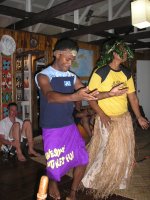 Our final kava party started on the beach, but had to be moved indoors when the rain started. We were treated to some Polynesian dancing along with our singing tonight. Dinner was Gord's barracuda. Yummy. We had one of my fish for lunch.
Our final kava party started on the beach, but had to be moved indoors when the rain started. We were treated to some Polynesian dancing along with our singing tonight. Dinner was Gord's barracuda. Yummy. We had one of my fish for lunch.
April 16th, 2006
The Guys: Isaac, Dan, Vo, Junior, Bate, Zacchariah
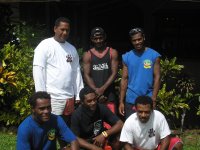
It was hard to leave! These people became good friends in a very short time. They sang to us as we left on the boat. They had given us all corsages, and they sang (in Fijian) "If you will come back to see us again, throw your flowers in the water". So of course we all did. Annalisse has requested that we return in two years time to take care of any dogs that we missed this trip, and of course any that have been born in the meantime.
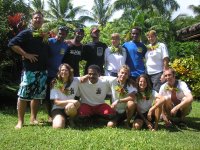

Our flight from Kadavu was delayed a little bit, and our team was split up. We got the smaller plane, and I was sitting right behind the co-pilot's seat. You can bet I was watching all those instruments closely! It was actually quite a nice flight, very little turbulence.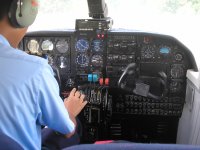
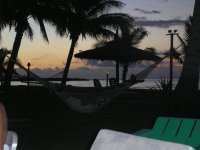
We did a bit of shopping in Nadi as we had several hours before our flight. We also had a wonderful dinner on the beach. We toasted each other and the work that we had done.

The flight home was long, but uneventful. No major turbulence this time, thank goodness. We flew into Hawaii with the most amazing sunrise out the window of the plane. We arrived home at 6pm to our families. I will miss the team, and the work, but it is always good to be home!
Last day of work! We were supposed to split into two groups, but one of the villages was in the opposite direction of the others. As we only had access to one boat today, we all headed back to near the airstrip. My group went to Namara, and the other two groups went to Namalota, just up the road.

Our group set up with a very shaky surgery table. It leaned. A lot. We had Joseph tell the villagers we were there, and asked him to round up some dogs. He came back a few minutes later with a two month old pup, a female. We sedated her, and Joseph was back a few minutes later with her two littermates, both females. Then an adult female and another female pup. Five spays in a row; haven't had to deal with that yet. A lot more stressful and time consuming! We got through them fine, and then had five neuters in a row, so it all evened out.
 The villagers were again very welcoming. The house we set up in front of made us hot chocolate and crackers. We left them our tarp as well as fishing line and hooks, as well as many toothbrushes and gifts. We again took pictures of the children and they all loved to see themselves. I even had a father ask to have his picture taken with his child.
The villagers were again very welcoming. The house we set up in front of made us hot chocolate and crackers. We left them our tarp as well as fishing line and hooks, as well as many toothbrushes and gifts. We again took pictures of the children and they all loved to see themselves. I even had a father ask to have his picture taken with his child.  It's nice to be able to do something so ordinary (to us) and have it give so much pleasure. Same for the surgeries I guess--it is so natural for us and we are so honoured to be able to come into their villages and use our talents--but they are tremendously grateful to us.
It's nice to be able to do something so ordinary (to us) and have it give so much pleasure. Same for the surgeries I guess--it is so natural for us and we are so honoured to be able to come into their villages and use our talents--but they are tremendously grateful to us. 
There were many more dogs in this village than the ten we were able to do. We asked owners of other dogs, but they didn't want their dogs to have the surgery. Unsure why, but we can't force them.
We met up with the other groups in the big village, and they had already done 30! While we were walking to them, there was a bit of a downpour--it only lasted a few minutes, but we were soaked. It was actually quite refreshing.
They had two dogs sedated when we arrived, so we took a neuter, while they did the other. We then did a cat neuter, and one other dog spay. Jus as we were getting going on the spay, the skies opened up. It was an amazing rainfall. It lasted for about ten minutes, and there were huge puddles when it was over. We had to move the surgery tables from under the trees to under cover as were were getting drenched.
We finished the surgeries and we packed up while they were recovering. As were were walking out of the village, we ran into the health officer for the area, so Terrill showed and explained the ear tags. He recommended we write up a report to the Agriculture officer (the one responsible for the poisonings) to be sure it was all documented so these dogs would be spared.
Up to this point, our total is 196 surgeries. We are very proud of what we have done here. There are 6-7 dogs in Zachariah's village that may be brought to the resort for us to do tomorrow, but even if we don't, we have done amazingly well. Now for a couple days rest before we head for home.
April 14, 2006
Well, in spite of no alarm, I was awake at 6:15. I lay in bed for awhile, then wandered down to the beach with a cup of coffee.
After breakfast, some of the group went diving. I sat on the beach and read my book and relaxed. There were four dogs and a cat brought form the nearby village, so I got set up for their surgeries and when everyone came back from diving, we did them. That brought our total to 201. We had some lunch and then the divers got ready for another dive. Gord and I got ready for some fishing!
 Zachariah took us out on the boat. He really wanted to find us some tuna. I just wanted to fish! I caught the first one, a big Spanish Mackerel. It was awesome--I don't think I've ever even seen a fish that big up close. The guys were mad, cause I used my "Heeeeeeere, fishy, fishy, fishy" lure and it worked! I caught then next one too. It was a bit smaller. Gord caught a big barracuda. It was a really great time. We saw an amazing sunset.
Zachariah took us out on the boat. He really wanted to find us some tuna. I just wanted to fish! I caught the first one, a big Spanish Mackerel. It was awesome--I don't think I've ever even seen a fish that big up close. The guys were mad, cause I used my "Heeeeeeere, fishy, fishy, fishy" lure and it worked! I caught then next one too. It was a bit smaller. Gord caught a big barracuda. It was a really great time. We saw an amazing sunset.
We showed off our catch and gave it to the kitchen. They said they would cook it for dinner tomorrow.
The rest of the evening was spent with a drink or two on the beach, and some great conversation. I was in bed early again. Just wiped from our two weeks here.

April 15th, 2006
Our last day...Up early again for coffee on the beach. After breakfast, most of us went either diving or snorkeling. I finally got brave and free dove down about 10 feet. It was so great. I got very close to the most beautiful fish. I've only ever been that close when they were in an aquarium.

It is a beautiful day for our last one here. Few fluffy white clouds, but otherwise blue sky and sunshine. I am sitting on the beach as I write this with a puppy around somewhere, and Scarface, the local dog, chasing a bird down the beach. Happiness is...
 See the puppy?
See the puppy?We went snorkeling again later, Donna, Norma and I. We kayaked out to a nearby reef. We took some great underwater photos. It was quite breezy and there was a bit of an undertow to contend with. Paddling back to shore took some muscles too!
 Our final kava party started on the beach, but had to be moved indoors when the rain started. We were treated to some Polynesian dancing along with our singing tonight. Dinner was Gord's barracuda. Yummy. We had one of my fish for lunch.
Our final kava party started on the beach, but had to be moved indoors when the rain started. We were treated to some Polynesian dancing along with our singing tonight. Dinner was Gord's barracuda. Yummy. We had one of my fish for lunch.April 16th, 2006
The Guys: Isaac, Dan, Vo, Junior, Bate, Zacchariah

It was hard to leave! These people became good friends in a very short time. They sang to us as we left on the boat. They had given us all corsages, and they sang (in Fijian) "If you will come back to see us again, throw your flowers in the water". So of course we all did. Annalisse has requested that we return in two years time to take care of any dogs that we missed this trip, and of course any that have been born in the meantime.


Our flight from Kadavu was delayed a little bit, and our team was split up. We got the smaller plane, and I was sitting right behind the co-pilot's seat. You can bet I was watching all those instruments closely! It was actually quite a nice flight, very little turbulence.


We did a bit of shopping in Nadi as we had several hours before our flight. We also had a wonderful dinner on the beach. We toasted each other and the work that we had done.

The flight home was long, but uneventful. No major turbulence this time, thank goodness. We flew into Hawaii with the most amazing sunrise out the window of the plane. We arrived home at 6pm to our families. I will miss the team, and the work, but it is always good to be home!
Subscribe to:
Posts (Atom)
